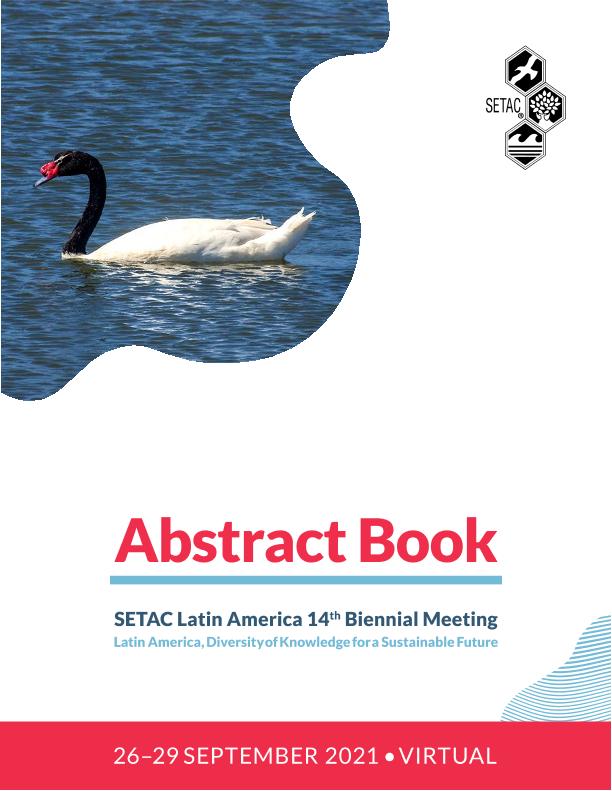Evento
Evaluation of the toxicity of sediments from a feedlot influenced area located in Northeastern Buenos Aires (Argentina) by bioassays with Hyalella curvispina
Murphy, K.; Oser, Federico Leandro ; Salgado Costa, Carolina
; Salgado Costa, Carolina ; Cellone, Francisco Aldo
; Cellone, Francisco Aldo ; Peluso, María Leticia
; Peluso, María Leticia ; Carol, Eleonora Silvina
; Carol, Eleonora Silvina ; Natale, Guillermo Sebastian
; Natale, Guillermo Sebastian
 ; Salgado Costa, Carolina
; Salgado Costa, Carolina ; Cellone, Francisco Aldo
; Cellone, Francisco Aldo ; Peluso, María Leticia
; Peluso, María Leticia ; Carol, Eleonora Silvina
; Carol, Eleonora Silvina ; Natale, Guillermo Sebastian
; Natale, Guillermo Sebastian
Tipo del evento:
Reunión
Nombre del evento:
Latin America 14th Biennial Meeting
Fecha del evento:
26/08/2021
Institución Organizadora:
Society of Environmental Toxicology and Chemistry;
Título del Libro:
Abstract Book: Latin America 14th Biennial Meeting
Editorial:
Society of Environmental Toxicology and Chemistry
Idioma:
Inglés
Clasificación temática:
Resumen
Intensive animal production of the feedlot type has spread in the Pampas region of Argentina. These activities can act as point sources of contamination if they are not properly designed and managed. The generation of large amounts of manure and its decomposition, releases, among other elements, nutrients that can infiltrate, or be transported by runoff and reach water courses where they can be captured by bottom sediments. A useful bioanalytical tool for diagnosing ecosystems is sediment toxicity bioassays. The aim of the study was to evaluate the toxicity of sediment samples from water courses in an area with present feedlot activity using Hyallela curvispina, a representative species of aquatic ecosystems of the neotropics. The study area is in a sub-basin of the El Pescado stream, northeast of the province of Buenos Aires, where a feedlot has been active since 2014. Four sediment samples were collected: 1) directly from a waterway that rounds the feeding lot, 2) from a waterbody located at the perimeter of the establishment, 3) from a permanent course of the sub-basin under study located 1 km downhill, and 4) from a reference site located 30 km from the feedlot. A bioassay (10 days) was performed following standardized protocols of the American Society for Testing Materials with minor modifications, placing 100 mL of sediment samples and 175 mL of water in 500 mL glass containers. Eight replicates per sample were used with 10 juveniles of H. curvispina. Mortality was determined by direct observation, and growth inhibition was assessed by measuring body length after digital photograph with the ImageJ program. In addition, physicochemical measurements (hardness, alkalinity, nutrients, among others) were made, and surface runoff and land use classification through the joint analysis of digital elevation models were evaluated using geographic information system tools. Sediments from the feedlot and the perimetral area showed significantly higher toxicity (p < 0.05) than the other ones, which showed less than 10% mortality. The results obtained allow us to conclude that the feedlot establishment is a locally pollution source, and toxicity bioassays are an efficient tool for the evaluation of environmental pollution. Future studies will focus on taking more samples from those sites where modeling and analysis of physicochemical parameters indicate whether pollutants are reaching the sites through runoff, and determining the pollution plume.
Palabras clave:
INTENSIVE ANIMAL PRODUCTION
,
SURFACE WATER
,
CONTAMINATION
Archivos asociados
Licencia
Identificadores
Colecciones
Eventos(CIG)
Eventos de CENTRO DE INVEST.GEOLOGICAS (I)
Eventos de CENTRO DE INVEST.GEOLOGICAS (I)
Citación
Evaluation of the toxicity of sediments from a feedlot influenced area located in Northeastern Buenos Aires (Argentina) by bioassays with Hyalella curvispina; Latin America 14th Biennial Meeting; Estados Unidos; 2021; 48-49
Compartir



